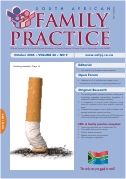Guidelines For Kangaroo Care In District Hospitals And Primary Health Care Maternity Sections In The Free State
Keywords:
Kangaroo Mother Care, Primary Health Care, Guidelines, premature babies
Abstract
Background Kangaroo care was started in 1979 in Bogotá, Colombia by Dr Edgar Ray and Dr Hector Martinez due to the shortage in resources and the large number of premature babies that needed special care. Kangaroo care implies direct skin-to-skin contact of the mother and her premature/new born baby. The advantages of Kangaroo care are well known and widely published. In National District hospital we admit stable babies from 1.2 kg and discharge the babies at around 1.8 kg when they can drink adequately. From 1.2 kg mothers practice daytime kangaroo care and the babies sleep in the incubator at night. Between 1.5 kg and 1.6 kg the mothers start with 24 hours kangaroo care. The aim of this study was to determine predictors for good and poor outcome in kangaroo mother care practiced at primary health care. This information was then used to compile guidelines for Kangaroo Care at primary care level hospitals and maternity sections. The aim of these guidelines are to give specific in and excluding criteria for kangaroo care, to indicate all the absolute and relative needs for such a unit and to give guidelines on follow up and what to do if a child has not gaining sufficient weight. Method In this cohort study patient files of premature babies that received kangaroo care in the National District Hospital were evaluated in order to establish indicators for good and poor outcome. Patient files were selected consecutively from the last entry in the admission register from May 2005 backwards until June 2003. Data was collected on a standard data collection form. Reasons for not gaining weight and the need for special investigations were investigated and noted. No weight gain or poor weight gain was regarded as weight gain of less than 17 g/kg/day. Results A total of 200 files were audited. Sixty two percent (95% CI 55.1%; 68.4%) of the babies gained weight satisfactory and 38% unsatisfactory. The mean admission weight of the babies for kangaroo care was 1545 g (range 1100g – 2100g) and the discharge weight was 1800g (range 1700 – 2100g). The chance of weight gain was reduced if one of the following occurred in a premature baby: anaemia, low body temperature, inappropriate amount and route of milk, sepsis, transport, procedures and other medical conditions. The re-insertion of naso-gastric tubes (53%), better temperature control with better kangaroo care technique (79%), the correction of anaemia with blood transfusion (12%) and the correction of the volume of milk (5%) were the major factors identified for not gaining weight that were addressed. In 29 % of cases extra energy in the form of FM 85 was added to the breast milk. The type of milk that the babies received namely: breast milk (n=113), premature milk formula (n=40) and a combination of breast milk and formula milk (n=46) did not significantly influence weight gain. Gender, birth weight and gestational age at birth also did not have a significant influence on weight gain. If properly addressed these babies gained weight on average within 4 days. Conclusion: It is possible to render safe kangaroo care on primary health care level to all stable premature babies if adhering to the set guidelines.
Published
2006-11-30
Section
Original Research
By submitting manuscripts to SAFP, authors of original articles are assigning copyright to the South African Academy of Family Physicians. Copyright of review articles are assigned to the Publisher, Medpharm Publications (Pty) Ltd, unless otherwise specified. Authors may use their own work after publication without written permission, provided they acknowledge the original source. Individuals and academic institutions may freely copy and distribute articles published in SAFP for educational and research purposes without obtaining permission.

